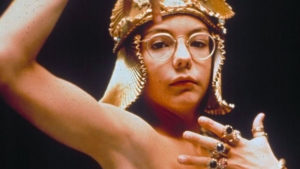Philosophers have seldom lived up to the ideal of radical doubt that they often claim as the prime directive of their tradition. They insist on questioning everything, while nonetheless holding onto many pieties. Foremost among these, perhaps, is the commandment handed down from the Oracle at Delphi and characterised by Plato as a life-motto of his master Socrates: “Know thyself.”
While this may seem an unassailable injunction, it is at least somewhat at odds with an equally ancient demand of Western philosophy, which may in fact be offered up in direct response to what the oracle says: “Don’t tell me what to do.” This response gets close to the spirit of the Cynics, who, like Plato, also believed they were following the teachings of Socrates, yet took his philosophy not to require some arduous process of self-examination, but only a simple and immediate decision to conduct one’s life according only to the law dictated by nature.
There are good reasons to defy the oracle beyond simply a distaste for taking orders. For one thing, it is not a settled matter that the commandment to “know thyself” can be followed at all, since it is not clear that there is anything to know. In the end the self may be the greatest “nothingburger” of all; there may simply be nothing there. The self may be an illusion, as most strains of classical Buddhist philosophy held; or it may be a “hole in being at the heart of Being”, as Jean-Paul Sartre disconsolingly suggested; or it may be perfectly real, but by definition beyond the bounds of knowability.
If you become convinced that the self is unknowable, there are a few different ways you might react. You might decide to “go with the flow”, to live out your days in happy ignorance of your “true” nature, but in sentimental harmony with the world around you. Or you might turn your attention to the body, as the closest thing you’re ever going to get to the self itself, and learn everything you can about it. In doing this, over time you and your peers might come to believe that the information derived from such investigation counts as self-knowledge in the fullest sense, that it is not just as good as it gets, but good purely and simply.
This impression that knowledge of the body’s “vital stats” is good in itself may come to appear particularly compelling when it presents itself not only as good, but as cool. And there is no more effective way to make learning cool than to make it depend on the intermediation of some sleek new device, some bit of technology, a gadget that did not exist at all just a few years before. In a world flooded with such new devices, it is not at all surprising to find that many people now are not even aware of any aspiration to self-knowledge beyond what may be revealed by the AppleWatch or the Fitbit.
Of course, these devices are only the tip of the iceberg. For some years we have heard reports of “tech bros” willingly cyborgising themselves to monitor a constant stream of data concerning their blood-sugar levels, or the chemical composition of their urine or sweat. Nor is such pervasive monitoring always part of a project of self-cultivation, nor even is it always voluntary. Doctors are increasingly able to monitor the vital signs of outpatients going about their lives far from the centres of medical care, and now we are starting to hear of pills that can send an electronic signal once they have arrived in their swallower’s stomach: a potential way of ensuring that a patient is adhering to some court-ordered medical regime of anti-psychotics, or even, potentially, of chemical castration.
It is not hard to imagine a near-future scenario in which countless data-points from all of our bodies are quietly and unceasingly transmitted to the cloud and available for inspection by “the authorities”: how many calories we consume per day, how often we get sexually aroused, as well as the old standards of steps, heart-rate, blood-sugar, and so on.
For now, anyway, most of these corporeal metrics are noted only by the person whose body they quantify, and they are noted, most commonly, as part of a project of what we may call “ersatz self-knowledge”: the kind of knowledge of who you are that can still be obtained even after you and your culture have given up on any conception of the true value of a human being.
But everything we have considered so far is only half the story. In a first phase of this materialist reduction of the self, the body is taken as a reliable source of the best sort of information that we may hope to obtain about who we are. In a more advanced phase, typical “soul activity” — all the things we do that are expressive of our agency and creativity — is passed through what are essentially the same metrical filters. The daily quota of steps for which our Fitbit — and perhaps also our health-insurer or our government — may be programmed to congratulate us is not so different, in the end, from the quantity of “likes” we feel, or are made to feel, are the appropriate recompense for the expression of some political opinion on social media.
In the Objections and Replies to the 1641 Meditations on First Philosophy, Thomas Hobbes made fun of René Descartes’s famous claim that we may know ourselves to exist from the fact that we think: “I think therefore I am.” Why not say instead, Hobbes wondered, “I walk therefore I am”? Whether or not Hobbes was fully appreciating the subtleties of the Cartesian Cogito, we may at least note that his observation was a sort of prophecy: in our present materialistic age, ambulation and cogitation really have become one and the same sort of thing. They are both, now, but fodder for metrics.
We know very well that the motion of megafaunal herds, like the behaviour of bacteria clustered into a cooperative brain-like system, may be modelled algorithmically. It is, therefore, not at all surprising that as thinking degenerates into like-seeking, as soul activity becomes a mere subset of measurable data, this activity is correspondingly conceived as if it were itself the output of an algorithmic process.
There is a familiar notion of “algorithm creep”, in which the gamified incentives that structure our online behaviour spread into other domains, such as labour (as when an Uber employee is compelled to pursue his work in pursuit of points, as if it were a video game), logistics, medicine, and, increasingly, the economy. But the ultimate case of algorithm creep, which might better be called “algorithm leap”, occurs when the rules that structure our experience of the online world jump across the screen and begin to structure our understanding of ourselves and of other human beings.
It is common, now, to read on the internet accounts of human action that model it on artificial systems, and that have no other resources for conceiving human motivation than those borrowed from programming, even when what is at issue is human moral failure. Let us consider one striking example from a few years ago. In 2020, a controversy was triggered by the behaviour of a well-known comic-book artist accused by numerous younger women, most of them fans of his work and aspiring comic-book authors, of sexually inappropriate behaviour, emotional manipulation, and what is known as “grooming”.
A website was set up for his proclaimed victims to share their testimonials. On this site, the author’s grooming behaviour is described as: “rel[ying] on subtle techniques that leverage ‘compulsion loops’, which are well-established in scientific literature and video gaming, and are commonly utilised by modern businesses to achieve addiction, AKA ‘user retention’. Examples include daily quests in games, getting a higher reward (more ‘XP’, etc.) for the first game of a day, more ‘karma’ for the first post of a day on a message board, etc. The main driver is a regular daily dopamine boost sustained over time.”
At issue here is the moral conduct of a person who in another era would have been accused of lechery, of being manipulative, of playing the cad. Here, the accusation against the comic-book author, however, eschews inherited moral categories, and blames him, effectively, for instantiating the same features we also know from our use of social media. The author has had programmed into him, it would seem, the same addictive hooks for which we rightly criticise Facebook. He now stands accused of “user retention”.
Nor is this modified use of language confined to the realm of human behaviour. Walter Benjamin’s 1935 essay, “The Artwork in the Age of Mechanical Reproducibility”, sought to chart the fate of art’s “aura” in an era in which likenesses of any given work may be generated cheaply and without limit. Effectively, in the age of the photograph, the Xerox, or the screenshot, all art becomes “allographic” — to see a copy of a work is for most purposes as good as seeing the real thing. Though there may be some qualities in the brushstrokes that only the original canvas can reveal, it is by now a plain social fact that the added value in the work itself, as when tourists leap over one another to take an iPhone photo of the Mona Lisa, is pure aura. To say that the aura is pure is to say that what gives the work its perceived value is by now entirely disconnected from its aesthetic properties, and entirely caught up in fantastical speculations as to how much money it could fetch, or how much it would cost the museum if someone were to slash it.
When culture arrives at this point, the NFT, though it has hit some bumps recently, cannot but become the artwork par excellence. Some people will still try, laughably, to feign connoisseurship and to explain to the rest of us yokels why the obscene price attached to some token or other derives from its aesthetic properties. But this is a bluff, for what we have in fact seen with the rise of the NFT is the literal convergence of art and money. A work can only be assessed, now, in terms of its financial value, and is therefore perfectly interchangeable with any other work of the same value. Financial value, in turn, becomes the ultimate metric — the one we are all really hoping to convert our likes and faves and followers into eventually, somehow. Otherwise the like-seeking that has taken away our souls over the past decade is just too sad to contemplate: we will have been doing it for literally nothing, not even money.
But while art may now seem fully elided with capital, this only relates to works of art that are put forth as candidates for exchange, which is to say works that have been entered into the metrics game. There is, of course, a vast reserve of other artworks, and an even vaster reserve of human creative potential, that lie outside of that whole bleak nexus — as, for example, the sweet and rough airs that come from an old bard’s broken singing voice, busking for change, as you walk past him in the metro. Such moments provide not only brief access to art in its unmetricised and therefore borderline-outlawed form. They can also have the power to summon us back to ourselves, to our proper selves: grounded only in phenomenal consciousness, and following no rule.
Disclaimer
Some of the posts we share are controversial and we do not necessarily agree with them in the whole extend. Sometimes we agree with the content or part of it but we do not agree with the narration or language. Nevertheless we find them somehow interesting, valuable and/or informative or we share them, because we strongly believe in freedom of speech, free press and journalism. We strongly encourage you to have a critical approach to all the content, do your own research and analysis to build your own opinion.
We would be glad to have your feedback.
Source: UnHerd Read the original article here: https://unherd.com





